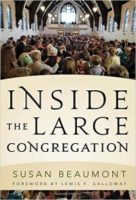Church staff approach the beginning of a program year with enthusiasm and energy, but as the year winds down, this often gives way to malaise and exhaustion. Staff rely on the summer months for revitalization before the cycle begins anew. This cycle of overwork, exhaustion and renewal has never been healthy, but during the pandemic, the summer hiatus has not offset months of overwork and stress. Many staff are running on empty—already burned out while the program year is still new.
It’s time to break the burnout cycle by instituting healthy, sustainable church workplace practices.
Burnout is a response to prolonged emotional, physical, and interpersonal stressors. It is characterized by chronic feelings of exhaustion, cynicism, and inefficacy. “I’m so tired. I just don’t care anymore. I’m working harder than I ever have and it isn’t making a difference.”
We tend to think about burnout as an individual problem—a breakdown in the way an employee is approaching their work. An absence of resilience. Or we think about it as an inevitable by-product of this liminal season. Something that everyone is experiencing and that has no solution. Instead, we need to approach burnout as a systemic problem with understandable causes and workable solutions.
Understanding Burnout
According to the Gallup organization, the top five reasons for employee burnout include:
- Unfair treatment at work
- Unmanageable workloads
- Lack of role clarity
- Lack of communication and support from a manager
- Unreasonable time pressure
The pandemic has been a breeding ground for these burnout factors among church staff. Job descriptions have morphed continuously over the past two years. Everything has been treated as urgent—all the time. The demands of the job have nearly doubled for some members of the team who are now expected to serve both in-person and online communities. Program participation and volunteerism are off. Boundaries around the beginning and end of a workday have vanished as employees try to blend working from home with working in the office.
Employees experiencing burnout undergo more illness, take more sick days, have less confidence in their ability to do their job, and are less likely to pursue performance goals. They are likely to be looking for a new job.
It’s not too late to address the factors causing burnout among your staff. Six sustained practices can help break the cycle of overwork in your congregation and create an energized year-round culture.
Revisit and Clarify Expectations
Most employees have responsibilities today that are significantly different from what they were doing two years ago. Online environments and evolving technology present new challenges. It is important that we reach new shared understandings about the essential functions and core competencies of each position on the team.
- Essential functions are the duties and tasks that define the responsibilities of a job.
- Core competencies are the attributes, characteristics, and skills the employee is expected to demonstrate as they engage their essential functions.
Ultimately, the supervisor has the authority to clarify the evolving expectations of the job. In most instances, the supervisor will choose to include the employee in designing a new job description to reflect the present demands of the role.
Decide Together What NOT to Do
An important part of clarifying role expectations involves articulating what an employee will STOP doing. Which employee responsibilities are no longer relevant, or as important as they used to be?
We need to encourage staff to say no to congregants who place inappropriate demands on their time. And we need to support the employee who says no when the congregant gets upset. We need to educate all our people about new role expectations and why we have stopped doing some of the things they have long valued.
Interrupt the Rumination Cycle
Burnout fuels catastrophic thinking—the “awfulizing” train of thoughts in which we foment worse case scenarios, and obsessively replay events gone wrong. In burnout we fall prey to black and white—all or nothing logic, which leads to circular worrying about all that might implode.
A helpful supervisor, mentor, or coach can often interrupt the rumination cycle with a simple observation, and an invitation to reframe the situation. “I’m noticing how inclined you are to imagine the worst-case scenario. Is there any evidence of a possible positive outcome? What potential opportunity can we find in this situation?”
We can introduce new behavioral norms in our staff meetings—for instance, imagining positive outcomes. “What if our hopes and dreams come to pass?”
Stop Meetings by Default
During the pandemic, we created many additional meetings to cope with rapidly changing priorities. We added these additional meetings without eliminating or reevaluating old ones.
New staff configurations require new meeting structures. It’s time to reexamine how many meetings you are having and what you hope to accomplish in each. Are you investing time in needless round-table reports? Can you streamline your agendas? Could some meetings be eliminated if you used an online calendar or project planning application?
Intercept the 24/7 work cycle
Working from home became the norm during Covid. During the emergency phase of the pandemic, many grew accustomed to a 24/7 response from our staff. As staff returned to the building, the habit of round-the-clock response remained.
Your employment policies should clarify when employees are expected to work and when they are expected not to work. This is critical for non-exempt employees, who legally must be paid overtime if they work more than 40 hours a week. Legally, the work week includes time spent responding to emails and text messages at home.
Strengthen Your Shared Sense of Why
One way to alleviate burnout is to revisit fundamental questions of purpose. Who are we? Whom do we serve? What do we stand for? What are we called to do next? Our responses to these questions are evolving. We should not assume that staff are operating with a shared sense of purpose now.
Instead, many staff are offering new programs in a desperate frenzy to rebuild in-person attendance. Many of these programs have little to do with our core purposes. It’s time to slow down, reevaluate, and learn. What difference are we trying to make? What portfolio of offerings will best help to make that difference?
These next years are critical to the future of the Church. We need staff who are energized, creative and purposeful leading the way. It’s time to break the old cycle of overwork leading to exhaustion. It’s time to invest in sustainable workplace practices that promote year-round vitality.
Susan Beaumont is a coach, educator, and consultant who has worked with hundreds of faith communities across the United States and Canada. Susan is known for working at the intersection of organizational health and spiritual vitality. She specializes in large church dynamics, staff team health, board development, and leadership during seasons of transition.
With both an M.B.A. and an M.Div., Susan blends business acumen with spiritual practice. She moves naturally between decision-making and discernment, connecting the soul of the leader with the soul of the institution. You can read more about her ministry at susanbeaumont.com.




